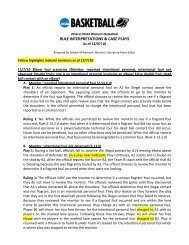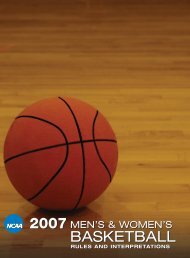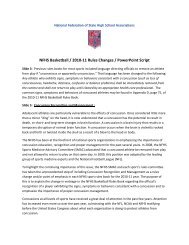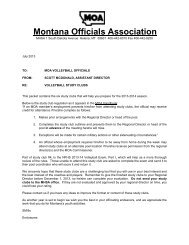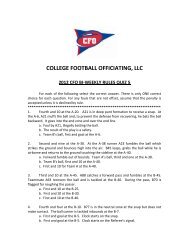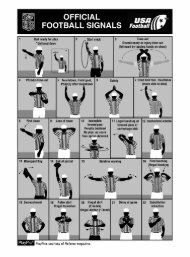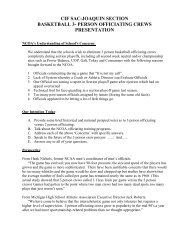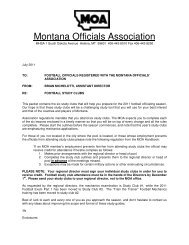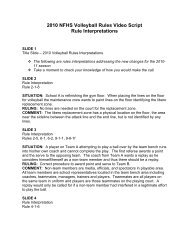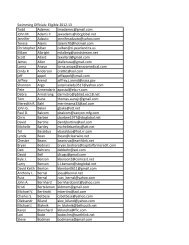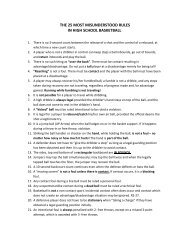2011-12 AND 2012-13 MEN'S AND WOMEN'S RULES - NAIA
2011-12 AND 2012-13 MEN'S AND WOMEN'S RULES - NAIA
2011-12 AND 2012-13 MEN'S AND WOMEN'S RULES - NAIA
You also want an ePaper? Increase the reach of your titles
YUMPU automatically turns print PDFs into web optimized ePapers that Google loves.
76<br />
RULE 6 / LIVE BALL <strong>AND</strong> DEAD BALL<br />
d. After a free-throw violation is committed by each team or technical foul<br />
occurs when there is no team control.<br />
e. A live ball lodges between the backboard and the ring or comes to rest on<br />
the flange. (Exception: Rule 9-5.1.c.)<br />
f. The ball becomes dead when neither team is in control and no goal or<br />
infraction or end of a period is involved.<br />
g. An inadvertent whistle occurs, and there is no player or team control.<br />
Art. 2. The direction of the alternating-possession arrow shall be reversed<br />
immediately after an alternating-possession throw-in ends. That throw-in shall<br />
end when a passed ball touches or is legally touched by an inbounds player or<br />
when a player, who is located on the playing court, touches and causes the ball to<br />
be out of bounds or when the throw-in team commits a throw-in violation<br />
Art. 3. The opportunity to make an alternating-possession throw-in shall be lost<br />
when the throw-in team violates the throw-in provisions. (See Rule 9-5.)<br />
Art. 4. A foul by either team during an alternating-possession throw-in shall not<br />
cause the throw-in team to lose the alternating-possession arrow.<br />
Section 4. Position for Jump Ball<br />
Art. 1. For any jump ball, each jumper shall have both feet inside the half of the<br />
center circle that is farther from his or her team’s basket.<br />
Art. 2. Each jumper may face in either direction.<br />
Art. 3. The referee or designee shall toss the ball upward between the jumpers<br />
in a plane at right angles to the sidelines, to a height greater than either of the<br />
jumpers can jump and so that the ball will drop between them. The jump ball may<br />
be repeated when these provisions are not met.<br />
Art. 4. When the ball touches the playing court without being touched by at least<br />
one of the jumpers, the official shall toss the ball again.<br />
Art. 5. The jump ball and these restrictions end when the ball touches one of the<br />
eight non-jumpers, the playing court, the basket, the backboard or when the ball<br />
becomes dead.<br />
Section 5. Dead Ball<br />
Art. 1. The ball shall become dead or remain dead when:<br />
a. Any goal is made.<br />
b. It is apparent that the free throw will not be successful on a free throw for<br />
a technical foul or a false double foul or a free throw that is to be followed<br />
by another free throw.<br />
c. A held ball occurs or the ball lodges between the backboard and the ring<br />
or comes to rest on the flange.<br />
d. An official blows the whistle except when the try is in flight.<br />
e. Time expires for a half or extra period.<br />
f. An official blows the whistle when a foul is committed by a shooter’s<br />
teammate before the ball is released for a try for goal.<br />
g. An official blows the whistle when any floor violation (Rules 9-3 through<br />
9-14) occurs, there is basket interference or goaltending (Rule 9-16) or<br />
there is a free-throw violation by the free-thrower’s team (Rule 9-1).




